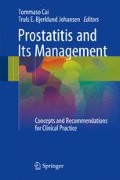Abstract
Prostatitis syndrome classification is mainly based on clinical and laboratory or instrumental characteristics. The NIH classification of prostatitis syndromes includes four different main categories: (1) acute bacterial prostatitis; (2) chronic bacterial prostatitis; (3) chronic prostatitis/chronic pelvic pain syndrome, (3a) inflammatory, (3b) noninflammatory; and (4) asymptomatic inflammatory prostatitis. This classification seems to be able to objectively characterize patients according to specific criteria but inefficient to determine the effects of different types of treatment on patient symptoms. On the other hand, the UPOINT classification has a six-point system as follows: U- urinary symptoms, P- psychological symptoms, O- organspecific symptoms (such as the prostate), I- infection-related symptoms, N- neurologic/systemic symptoms, and T- tenderness in the muscles and pelvic floor symptoms. In the case of chronic abacterial prostatitis, the UPOINT phenotyping allows to orient appropriate treatments and to demonstrate encouraging results in terms of clinical response and therapeutic success.
Access this chapter
Tax calculation will be finalised at checkout
Purchases are for personal use only
References
Grabe M, Bartoletti R, Bjerklund-Johansen TE, Cek M, Koves B, Naber KG, Pickard RS, Tenke P, Wagenlehner F, Wullt B (2015) EAU guidelines on urological infections. The European association of Urology, Arnhem (NL). 2015 edn, pp 42–46. http://uroweb.org/wp-content/uploads/19-Urological-infections_LR2.pdf
Tripp DA, Nickel JC, Wang Y, Litwin MS, McNaughton-Collins M, Landis JR, Alexander RB, Schaeffer AJ, O’Leary MP, Pontari MA, Fowler JEJ, Nyberg LM, Kusek JW (2006) Catastrophizing and pain-contingent rest predict patient adjustment in men with chronic prostatitis/chronic pelvic pain syndrome. J Pain 7:697
Krieger JN, Egan KJ, Ross SO et al (1996) Chronic pelvic pain represent the most prominent urogenital symptoms of “chronic prostatitis”. Urology 48:715–722
Meares EM, Stamey TA (1968) Bacteriologic localization patterns in bacterial prostatitis and urethritis. Invest Urol 5:492–518
Krieger JN, Nyberg L Jr, Nickel CJ (1999) NIH consensus definition and classification of prostatitis. JAMA 281(3):236–237
Schaeffer AJ (1999) Prostatitis: US perspective. Int J Antimicrob Agents 11:2015–2211
Bullones Rodriguez MA, Afari N, Buchwald DS, the NIDDK diseases working group on Urological Chronic Pelvic Pain (2013) Evidence for overlap between urological and nonurological unexplained clinical conditions. J Urol 189(Suppl 1):S66–S74
Welch RA, Burland V, Plunkett III G, Redford P, Roesch P, Rasko D, Buckles EL, Liou SR, e collaboratori (2002) Extensive mosaic structure revealed by the complete genome sequence of uropathogenic E. coli. Proc Natl Acad Sci U S A 99:17020–17024
Cottell E, Harrison RF, McCaffrey M, Walsh T, Mallon E, Barry-Kinsella C (2000) Are seminal fluid microorganism of significance or merely contaminants? Fertil Steril 74:465–470
Gandaglia G, Briganti A, Gontero P, Mondaini N, Novara G, Salonia A, Sciarra A, Montorsi F (2013) The role of chronic prostatic inflammation in the pathogenesis and progression of benign prostatic hyperplasia (BPH). BJU Int 112:432–441
Weidner W, Anderson RU (2008) Evaluation of acute and chronic bacterial prostatitis and diagnostic management of chronic prostatitis/chronic pelvic pain syndrome with special reference to infection/inflammation. Int J Antimicrob Agents (31 Supp 1):S91–5
WHO (2010) WHO laboratory manual for the examination and processing of human semen, 5th edn. WHO press, Geneva
Bartoletti R, Cai T, Mondaini N, Dinelli N, Pinzi N, Pavone C, Gontero P, Gavazzi A, Giubilei G, Prezioso D, Mazzoli S, Boddi V, Naber KG, Italian Prostatitis Study Group (2007) Prevalence, incidence estimation, risk factors and characterization of chronic prostatitis/chronic pelvic pain syndrome in urological hospital outpatients in Italy: results of a multicenter case-control observational study. J Urol 178(6):2411–2415; discussion 2415
Litwin MS, McNaughton-Collins M, Fowler FJ Jr, Nickel JC, Calhoun EA, Pontari MA, Alexander RB, Farrar JT, O’Leary MP (1999) The National Institutes of Health chronic prostatitis symptom index: development and validation of a new measure. Chronic prostatitis collaborative research network. J Urol 162(2):369–375
Shoskes DA, Nickel JC, Rackley RR, Pontari MA (2009) Clinical phenotyping in chronic prostatitis/chronic pelvic pain syndrome and interstitial cystitis: a management strategy for urologic chronic pelvic pain syndromes. Prostate Cancer Prostatic Dis 12(2):177–183
Shoskes DA, Nickel JC (2013) Classification and treatment of men with chronic prostatitis/chronic pelvic pain syndrome using the UPOINT system. World J Urol 31:755–760
Zhao Z, Zhang J, He J, Zeng G (2013) Clinical utility of the UPOINT phenotype system in chinese males with chronic prostatitis/chronic pelvic pain syndrome (CP/CPPS): a prospective study. PLoS One 8:e52044
Shoskes DA, Nickel JC, Dolinga R, Prots D (2009) Clinical phenotyping of patients with chronic prostatitis/chronic pelvic pain syndrome and correlation with symptom severity. Urology 73:538–542
Magri V, Wagenlehner F, Perletti G, Schneider S, Marras E, Naber KG, Weidner W (2010) Use of the UPOINT chronic prostatitis/chronic pelvic pain syndrome classification in European patient cohorts: sexual function domain improves correlations. J Urol 184:2339–2345
Upoint system for the clinical phenotyping of chronic pelvic pain. www.upointmd.com
Author information
Authors and Affiliations
Corresponding author
Editor information
Editors and Affiliations
Rights and permissions
Copyright information
© 2016 Springer International Publishing Switzerland
About this chapter
Cite this chapter
Bartoletti, R., Cai, T. (2016). Classification of Prostatitis: What Is the Clinical Usefulness?. In: Cai, T., Bjerklund Johansen, T. (eds) Prostatitis and Its Management. Springer, Cham. https://doi.org/10.1007/978-3-319-25175-2_4
Download citation
DOI: https://doi.org/10.1007/978-3-319-25175-2_4
Published:
Publisher Name: Springer, Cham
Print ISBN: 978-3-319-25173-8
Online ISBN: 978-3-319-25175-2
eBook Packages: MedicineMedicine (R0)

